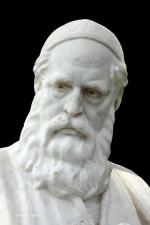Disable ads!
Omar Khayyam
"Khayyam" redirects here. For other uses, see Khayyam (disambiguation). Omar Khayyám; born Ghiyāth ad-Dīn Abu'l-Fatḥ ʿUmar ibn Ibrāhīm al-Khayyām Nīshāpūrī (/ˈoʊmɑr kaɪˈjɑːm, -ˈjæm, ˈoʊmər/; Persian: غیاث الدین ابوالفتح عمر ابراهیم خیام نیشابورﻯ , pronounced [xæjˈjɒːm]; 18 May 1048 – 4 December 1131), was a Persian mathematician, astronomer, philosopher, and poet. He also wrote treatises on mechanics, geography, mineralogy, music, and Islamic theology. Born in Nishapur in North Eastern Iran, at a young age he moved to Samarkand and obtained his education there. Afterwards he moved to Bukhara and became established as one of the major mathematicians and astronomers of the medieval period. He is the author of one of the most important treatises on algebra written before modern times, the Treatise on Demonstration of Problems of Algebra, which includes a geometric method for solving cubic equations by intersecting a hyperbola with a circle. He contributed to a calendar reform. His significance as a philosopher and teacher, and his few remaining philosophical works, have not received the same attention as his scientific and poetic writings. Al-Zamakhshari referred to him as “the philosopher of the world”. He taught the philosophy of Avicenna for decades in Nishapur, where Khayyám was born and buried. His mausoleum there remains a masterpiece of Iranian architecture visited by many people every year. Outside Iran and Persian speaking countries, Khayyám has had an impact on literature and societies through the translation of his works and popularization by other scholars. The greatest such impact was in English-speaking countries; the English scholar Thomas Hyde (1636–1703) was the first non-Persian to study him. The most influential of all was Edward FitzGerald (1809–83), who made Khayyám the most famous poet of the East in the West through his celebrated translation and adaptations of Khayyám's rather small number of quatrains (Persian: رباعیات rubāʿiyāt) in the Rubaiyat of Omar Khayyam. Omar Khayyám died in 1131 and is buried in the Khayyam Garden at the mausoleum of Imamzadeh Mahruq in Nishapur. In 1963, the mausoleum of Omar Khayyam was constructed on the site by Hooshang Seyhoun.
 Read more on wikipedia.org Read more on wikipedia.org
 All quotes by Omar Khayyam All quotes by Omar Khayyam
 Edit Edit
|

|
|
|
|
|
Background photo by Giuliana
|